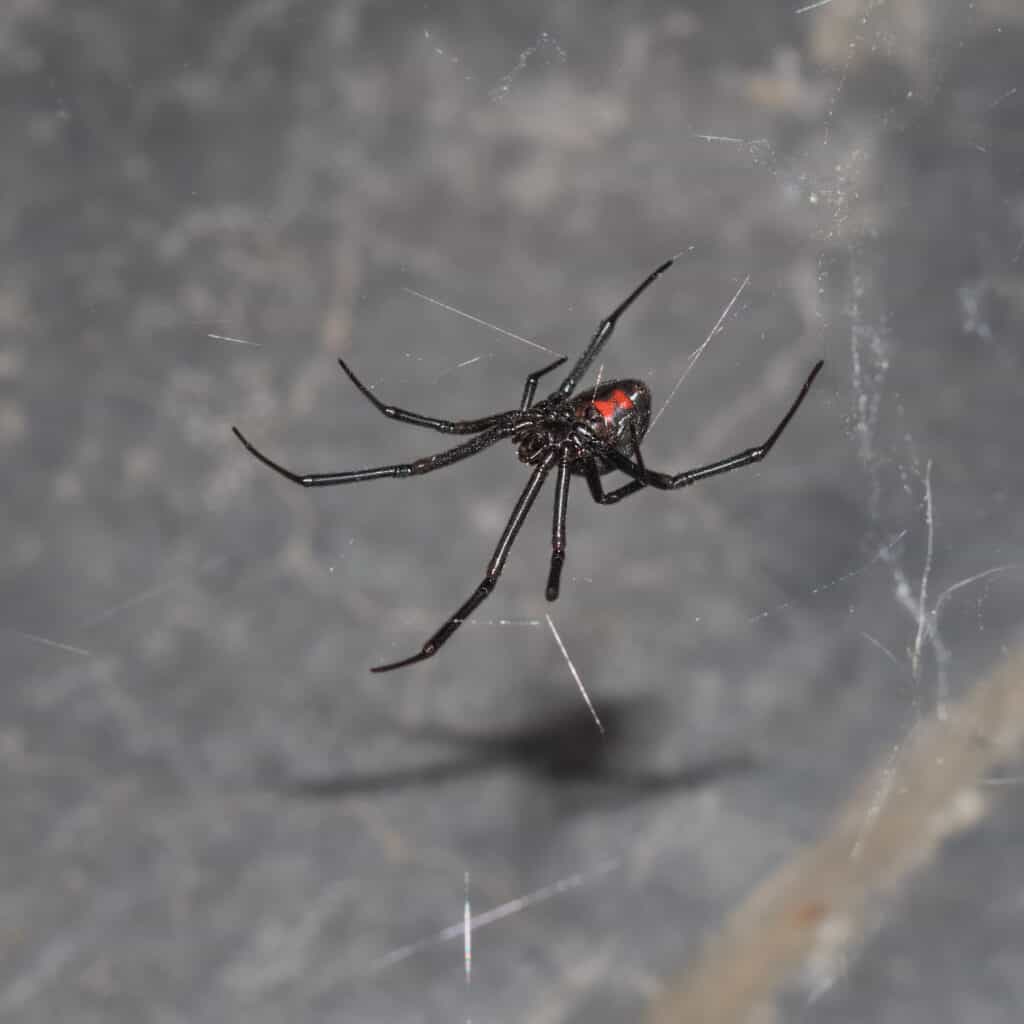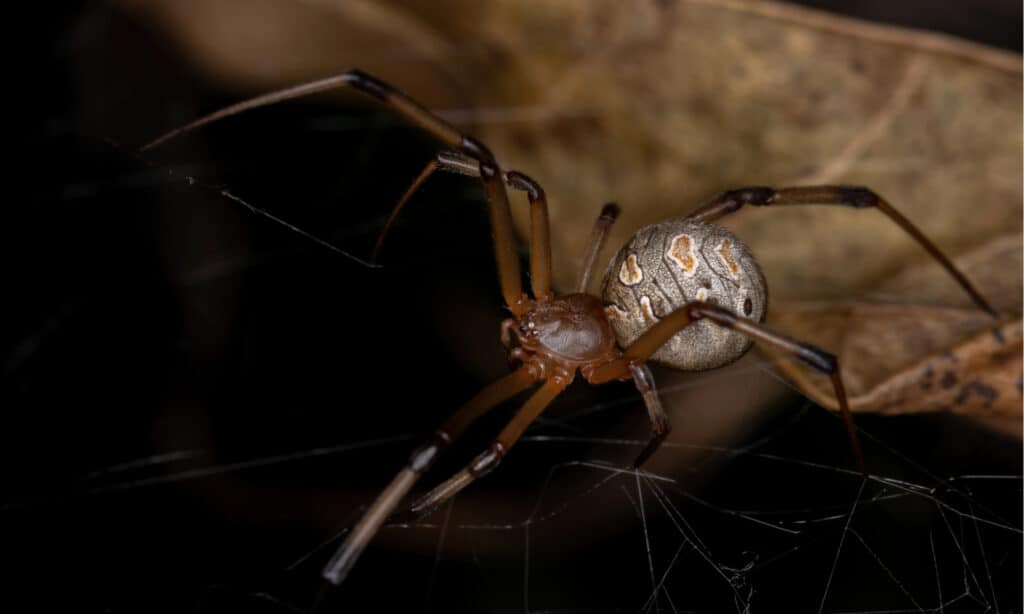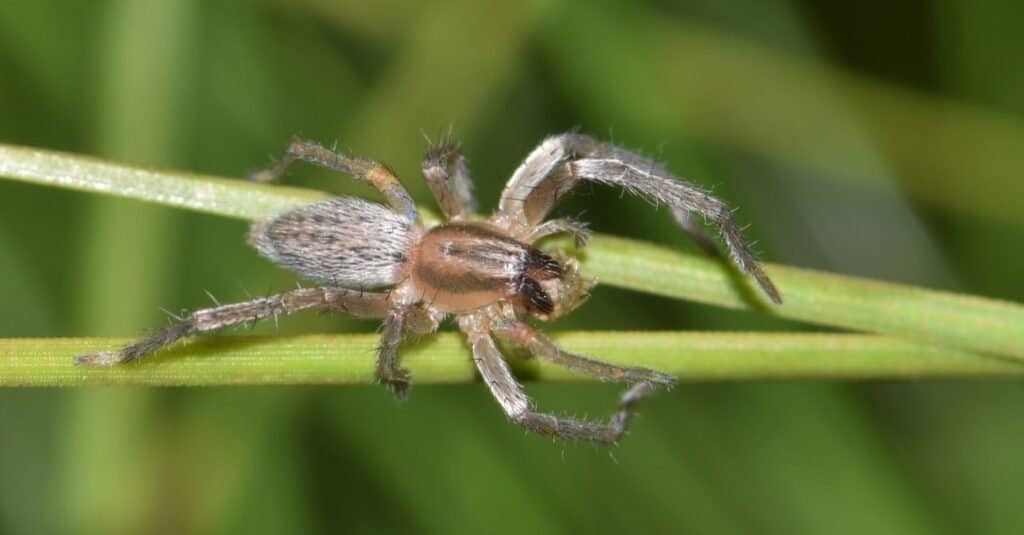
California, a state known for its diverse wildlife, is also home to a variety of spiders. While most of the spiders are harmless, a few have a poisonous bite that can pose a health risk. Let’s dive deep into the world of these venomous spiders, their distinctive features, habitats, and the precautions you can take to avoid them. Remember, if you ever encounter an issue with these spiders, don’t hesitate to reach out to Banner Pest Services, your friendly neighborhood experts in spider control!
The Dark Lethality: Western Black Widow Spider

Western Black Widow Spider (Image: iStock.com/Shravan Sundaram Photography)
The Western Black Widow Spider, a renowned species among the venomous spiders in California, is recognized for its jet-black color and red hourglass-shaped marking on the lower abdomen. This spider, native to the western regions of North America, holds a notorious reputation, particularly the females of the species.
Identifying Western Black Widow Spider
The male and female Western Black Widows exhibit significant differences in their physical attributes. The females, usually around half an inch long, display a jet-black color, whereas the males, half the size of females, showcase a tan color with lighter-colored stripes on their abdomen. The females’ distinctive red hourglass-shaped marking is often the key identifier; however, it can sometimes be yellow or white.
An irregular web, often referred to as “messy,” is another characteristic of this spider. Unlike other spiders that build spiral or tunnel-shaped webs, the Western Black Widow’s web follows no specific pattern.
The Bite of the Western Black Widow
It’s essential to understand that these spiders are not naturally aggressive. They tend to bite only when threatened or disturbed, especially if the female is guarding her eggs. The female’s venom, containing neurotoxins, can cause symptoms such as pain, nausea, and sweating in humans. Although the development of antivenom has made the bites rarely fatal, it’s always better to seek immediate medical attention if bitten.
The Subtle Assailant: Brown Widow Spider

Brown Widow Spider (Image: Vinicius R. Souza/Shutterstock.com)
Another member of the venomous spiders in California is the Brown Widow Spider. This species, a close relative of the Black Widow, is smaller and lighter in color, ranging from tan to dark brown, grey, or black.
Identifying Brown Widow Spider
Distinct black and white patterns on the dorsal side of its abdomen, and a prominent orange-yellow hourglass shape, characterize the Brown Widow Spider. Another unique identifier is its egg sacs, which have spiky, pointed projections all over, giving them a distinctive appearance.
The Bite of the Brown Widow Spider
Brown Widow Spiders, though venomous, are less dangerous than their black counterparts. Their bite is painful, but they deliver a minuscule amount of venom – a neurotoxic venom that affects the bite area and surrounding tissue. Yet, like all spider bites, medical attention is critical if bitten by a Brown Widow.
The Desert Phantom: Desert Recluse Spider

Desert Recluse Spider (Image: DesertTrip / CC BY-SA 4.0, via Wikimedia Commons)
Often misidentified as the Brown Recluse, the Desert Recluse Spider is another venomous species found in California. They predominantly inhabit the hot and humid eastern desert regions of Southern California.
Identifying Desert Recluse Spider
The Desert Recluse Spider, small and tan or yellowish-tan in color, is hard to spot due to its size and color. Its most distinguishing feature is the “violin-shaped” or “fiddle-shaped” mark and six eyes instead of eight. The spiders reside in areas mostly uninhabited by humans, especially amidst dense vegetation and near packrat dens.
The Bite of the Desert Recluse Spider
The Desert Recluse’s bite is venomous and the symptoms vary from almost no effect to severe complications, and even death in very rare instances. The venom can damage the skin and surrounding tissues, causing lesions that take weeks to heal. Immediate medical attention is necessary in the event of a bite.
The Imported Danger: Chilean Recluse Spider

Chilean Recluse Spider (Image: Ssiltane / CC BY-SA 4.0 – License)
The Chilean Recluse Spider, originally from Chile, is found in Southern California and the Los Angeles area. Known as the most dangerous of all recluse spiders, they typically avoid human interaction.
Identifying Chilean Recluse Spider
This recluse species is larger than the others, with a body length ranging from 0.31-1.57 inches. They are brown with violin-shaped markings on their dorsal thorax, and like other recluse spiders, they have six eyes arranged in pairs.
The Bite of the Chilean Recluse Spider
The Chilean Recluse is venomous and can cause significant harm, especially to the skin. Symptoms range from mild skin irritation to severe skin necrosis and destruction of soft tissue, which may take months to heal. Immediate medical attention is highly recommended in case of a bite.
The Night Prowler: Yellow Sac Spider

Yellow Sac Spider (Image: Brett Hondow/Shutterstock.com)
The Yellow Sac Spider, another member of the venomous spiders in California, is a tiny species found predominantly in urban areas of Western California. As the name suggests, they sport a beige or yellow color, with dark brown or black markings on their palps, jaws, and feet.
Identifying Yellow Sac Spider
Female Yellow Sac Spiders measure between 0.2 and 0.35 inches, with males having a narrower body and a larger leg span. The spiders have an orange-brown stripe running down the abdomen from top to center.
The Bite of the Yellow Sac Spider
Though venomous, Yellow Sac Spiders rarely bite humans. The venom causes moderate pain, followed by itching and swelling, which usually resolves within 7-10 days. Despite the bites rarely being fatal, medical attention is always advised.
Precautionary Measures
Detecting Spider Bites
Spider bites often resemble any other bug bite, presenting as a red and inflamed bump on the skin. Venomous spider bites, however, may appear as a small white blister with a red ring around it, resembling a bull’s eye. The skin in the middle of the bite might turn blue or purple, turning into an open sore. Symptoms of a venomous spider bite may include an itchy skin rash, sweating, fever, muscle cramps, nausea, vomiting, increased saliva production, headache, swollen eyes, or difficulty breathing.
Treatment for Spider Bites
If bitten by a venomous spider or if you’re unsure about the type of spider, it’s crucial to seek immediate medical attention. For non-venomous bites or if you don’t exhibit any allergic reaction symptoms, the bite can be treated at home. Clean the wound with mild soap and water, apply antibiotic ointment three times a day, and if needed, use a cool compress for 15 minutes to reduce pain and inflammation.
Preventing Spider Infestation
Seal any cracks or openings in windows and doors to prevent spiders from entering your home. Keep the exterior of your house clutter-free as it can provide shelter for spiders. Regularly clean dark and secluded areas of your home like basements, attics, and crawl spaces. Also, consider using an insecticide around your home’s exterior to discourage spiders.
Remember, while spiders can be a nuisance, they also play a crucial role in controlling pests. However, if you feel overwhelmed by a spider infestation, get in touch with Banner Pest Services for expert help in keeping your home spider-free!
Conclusion
While the presence of venomous spiders in California may seem intimidating, remember that spiders, in general, are not aggressive and usually bite only when threatened. Knowledge about these spiders, their habitats, and the precautionary measures can go a long way in ensuring your safety. In any case, professional help is always at your disposal with Banner Pest Services ready to assist you in maintaining a safe and spider-free environment.


